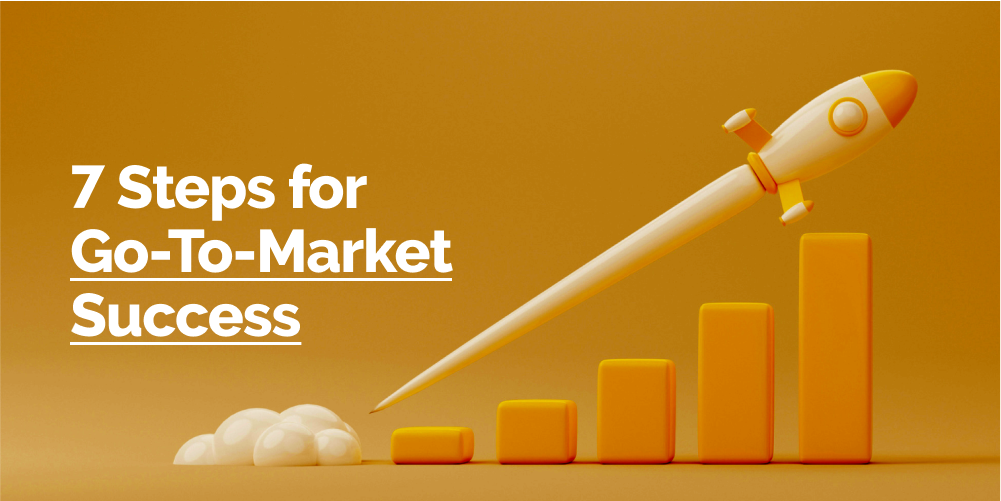Business Transformation, zBlog
7 Essential Steps to Execute Your GTM Strategy in 2024
atif | Updated: December 14, 2023

GTM Strategy: Introduction
You’ve developed a breakthrough product idea that you strongly believe can disrupt and transform the market. But turning that visionary lightbulb moment into commercial success requires intricate go-to-market strategy and flawless execution.
By intently focusing energy across these 7 essential steps for developing a GTM strategy, you can systematically de-risk your launch and maximize traction potential:
1. Validate Your Value Proposition Through Rigorous Early Testing

Before locking in engineering requirements or product positioning, early customer discovery conversations are crucial to validate if your idea solves a timely buyer pain point. Is there a solid product-market fit based on how target users respond to proposed features, messaging, and pricing?
HubSpot ran over 350 beta tests with customers to refine the pricing model and feature set for its initial Marketing Hub before full launch – pivoting from $500 per month to $50 per month based on customer feedback.
Additionally, research by CBInsights surveying 500 failed startup founders found that 72% could have potentially survived had they focused more attention on early product validation with real buyers vs. prematurely rushing to launch.
2. Define Your Target Customer Personas and Buyer Journeys
Rather than attempting to serve every potential customer segment right out the gate, a successful go-to-market strategy smartly prioritizes only your 3-5 highest-value persona archetypes for the initial launch.
For example, the music streaming app Spotify notably targeted only tech-savvy millennials in Scandinavia for its first 2 years in the market, rather than chasing mass market segments early on. This focus informed product design and marketing decisions that steadily improved activations and improved customer success metrics amongst those core influencers first.
You should map out detailed buyer journeys for each priority customer persona – identifying their points of friction with current solutions and how your offering uniquely delivers value. Exhaustively roleplaying product scenarios and use cases with prototypes helps further build empathy at each buyer journey stage.
3. Map Out a Compelling Product Narrative and Positioning

The most underappreciated element of a GTM strategy is aligning executives, product managers, and sales teams around consistent market positioning and customer messaging.
Why will your new offering uniquely compel customers to say “yes” over sticking with current solutions? What drives switching behavior? Crafting concise, externally focused messaging and validating that resonance with advisors is invaluable.
For example, Apple invested tremendous effort in scripting out and continually refining its launch messaging to industrial designers for the original iPhone unveiling in 2007 and subsequent influencer briefings. This ensured Apple’s internal teams and external partners communicated the aspirational product narrative consistently across global launch events.
4. Design and Validate a Scalable Sales Process
Every sales rep speaking with prospects should consistently trigger core buying triggers aligned to your customer personas’ emotions and pain points. Thus, developing repeatable sales processes, Battlecards, and pitch decks purpose-built for your go-to-market is mission critical.
Salesforce dedicates over 60% of customer-facing sales reps’ time just to fine-tuning how its messaging best resonates with targeted lines of business during multimillion-dollar enterprise expansions.
Similarly, before launching 1:1 sales outreach, software company Zenefits prototyped and ran market response surveys on dozens of unique email outreach templates. Based on target persona reactions to each, they doubled response rates from 7% to 15%+ in their sale sequence early on.
5. Right-Size Your GTM Resourcing and Invest Behind It

The biggest go-to-market mistake most early-stage startups make is a lack of appropriate investment into the customer-facing capabilities needed for commercializing and supporting a new product effectively at scale.
Investing just 20-30% of early funding rounds into building high-caliber product marketing, sales, partnerships/channels, customer success, and support functions pays exponential dividends later on.
For example, Kabbage’s executives devoted over 50% of the fintech‘s first $100 million in equity funding to building a world-class sales organization with its underlying small business lending technology. This focus increased its funded loan portfolio 10x in under 3 years.
Additionally, Startup Genome research highlights pre-scaleup startups that eventually break past $1 million+ in revenue and maintain nearly 3X as many sales representatives as peers stagnating under $1 million in sales.
6. Piggyback on Existing Marketplace Ecosystems
Rather than attempting the heavy lift of building out 1:1 distribution channels entirely from scratch, emerging offerings should tap into existing marketplace ecosystems with embedded audiences.
For example, the developing investing app Robinhood was able to rapidly gain mainstream millennial adoption by launching exclusively on Apple and Google’s mature, trusted app stores initially. This allowed them to piggyback on the platforms’ concentrated customer demand and frictionless distribution vs. trying to drive mass awareness alone.
Similarly, Salesforce accelerates its market momentum by nurturing a robust ecosystem of third-party consultancies and system integrators rather than solely relying on its 1st party professional services team to propel deployments.
7. Launch a Minimum Viable Offering First, Then Iterate

While it’s tempting to postpone releasing your “perfect” product until every last feature is built, taking an MVP approach gets crucial customer feedback faster to inform subsequent product iterations and market strategy.
Reid Hoffman of LinkedIn summarizes this mindset best: “If you are not embarrassed by the first version of your product, you’ve launched too late.”
A launch focused on activating early adopters first rather than complete mainstream readiness also informs pricing, Partnerships, and customer success decisions for long-term scale. Gradually transitioning toward expanded customer profiling, transaction optimization, and operational maturity over 2-3 years is typically needed to transform an MVP into a scaled Market leader.
According to McKinsey, B2B companies able to nail down refining both their core product value and go-to-market execution over time increase average contract values by over 75% and drive 60%+ bigger client deal sizes. But this compounding effect takes years of customer research, iteration, and organizational learning.
Conclusion
In conclusion, aligning methodically across these 7 make-or-break go-to-market focus areas before launch can ultimately maximize your disruptive offering’s market impact trajectory from Day 1. Then maintaining rigorous GTM consistency and execution discipline over years compounds success. In this transformative journey, Trantor, with its unparalleled expertise in crafting and executing innovative Go-to-Market strategies, stands as a trusted partner, propelling your vision beyond limits and ensuring sustained success in the dynamic market landscape.
It’s time to leverage these proven tips on forming a winning GTM strategy to drive your game-changing idea from the lightbulb concept to billion-dollar market domination!




